Photos of rivers from space
Rivers cut their way across continents, somewhere along a stable fortified channel, and somewhere freely spilling over the surface. The myriads of drawn lines are best seen from space.
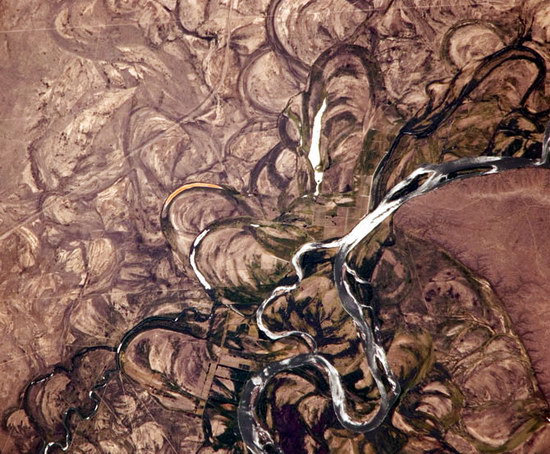
In this gallery we collected photos from satellites and astronauts made on the most beautiful and interesting rivers in the world. Photos are clickable.
Rio Negro, Argentina
The Argentine Rio Negro is a great example of how fluid rivers are. This is one of the most winding rivers in South America. The photo above was taken by astronauts of the International Space Station on January 4th, it shows that the river left traces behind it throughout the territory. Some old sleeves are still filled with water (old ladies).
')
Mississippi, United States
Over the past 10,000 years, the Mississippi River has created more than 320 km of the Gulf Coast in the delta, selecting new channels for approximately every thousand years. If you do nothing with her, she will continue her journey. Attempting to keep the Mississippi River in place is one of the daunting challenges facing the US Army Corps of Engineers. This is the longest river in North America (3,730 km).
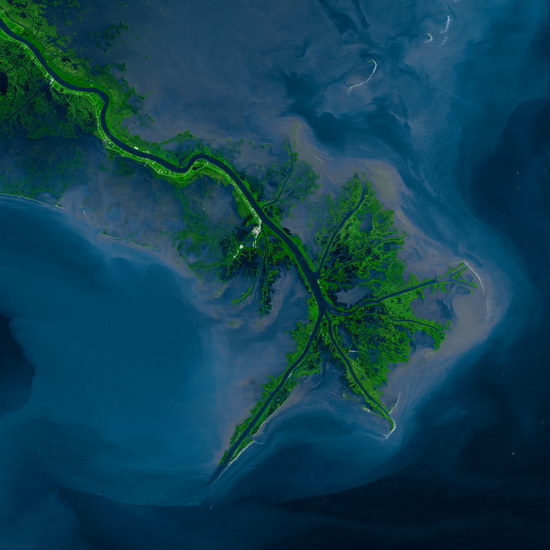
The photo above was taken in 2001 by the Landsat 7 satellite, showing the current 50 km delta that Mississippi had chosen 600 years ago.
The picture below was taken by the GeoEye Ikonos satellite after the river broke through two dams in June 2008 and flooded the city of Gulfport (Illinois).
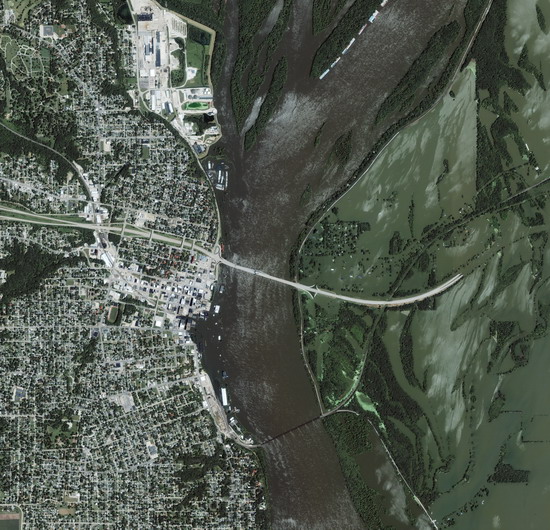
Ganges, India
The fake colors from the Ganges Delta were obtained from Landsat 7 satellite in 2000.
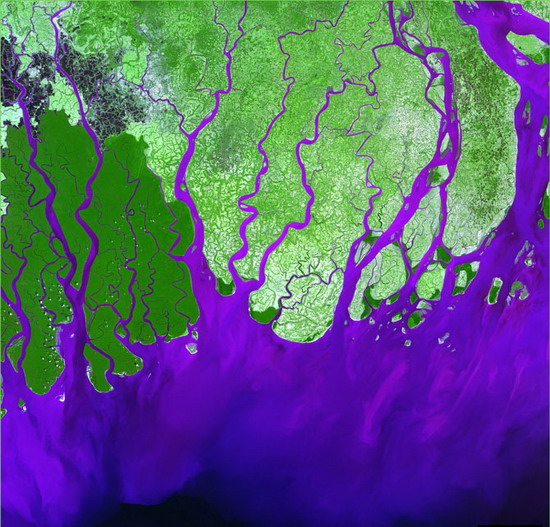
Sandy bare soils are filtered white, and unique forest swamps, the birthplace of the royal Bengal tiger, are marked in green. The river length of 2510 km originates in the Himalayas, and flows into the Bay of Bengal.
San Juan, Colorado

The small San Juan River has a length of just 640 km across the states of Colorado, New Mexico, and Utah, before flowing into the Colorado River. The photograph shows a plot in the Gooseneck National Park (translated as "duck neck"), which is so named for the crazy gyrus of the river. In some places, 5 kilometers of the river are “packed” on one kilometer of territory. This is a very popular place for rafting.
Nile, Egypt
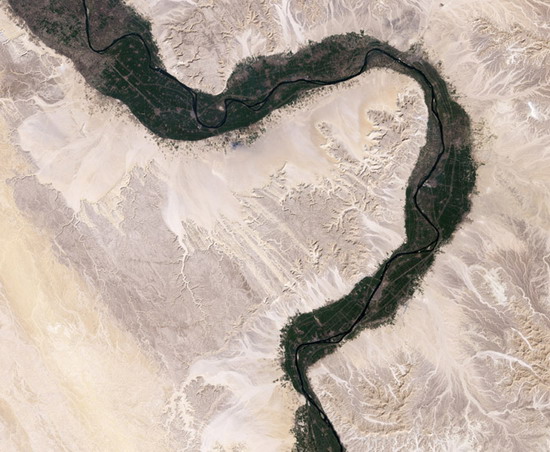
The Nile River is the only source of fertility in the waterless Egyptian desert, without which life would have been impossible here. Agriculture is conducted exclusively in the Nile Valley, with an average width of 10 km. The border between the valley and the desert clearly stands out in the pictures.
Below is the Nile delta in the Mediterranean, a photograph from the satellite Terra.
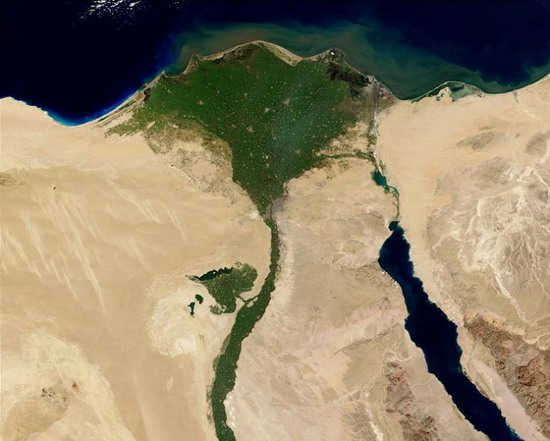
Lena, Russia
The tenth longest river in the world has a length of about 4,400 km and a basin of 2500 thousand km 2 in Eastern Siberia.

Lena’s Delta, shown in fake colors from Landsat 7 (2000), starts about 150 km from the Laptev Sea, this is one of the largest river deltas in the world, it is frozen for about seven months a year. There is the largest reserve in Russia.
Colorado and Green River, Utah
Green River (left) meets Colorado in the middle of Canyonlands National Park in Utah (photo by GeoEye). Immediately after this, the Cataract canyon begins, also famous among extreme rafters.
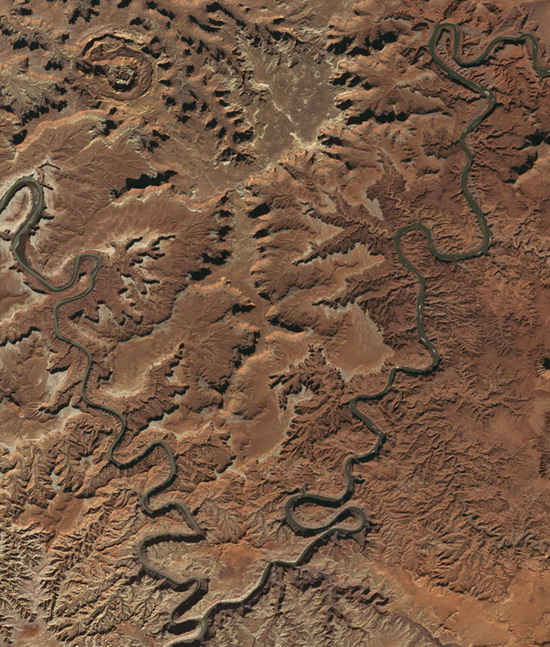
The rounded structure in the photo below is the Upheaval Dome. It was so named because geologists used to think that it could have been formed as a result of squeezing underground layers out. But recently it was proved that this is a crater of cosmic origin (the photo was taken by ISS astronauts in 2007).

Morari, Tibet
The rivers that flow into Lake Morari on the Tibetan plateau, for many years formed the so-called fan. Now the water has to find a new path to get into the drain (to the left of the cone).

Niagara Falls
Unfortunately, from space it is not very convenient to shoot vertical structures, such as a waterfall. You need to pick a suitable angle.

Niagara Falls is actually three falls. The width of the longest waterfall "Horseshoe" - 792 meters. The volume of falling water reaches 5720 m 3 / s. Under the waterfall built hydroelectric power stations, which currently produce up to 4.4 gigawatts of electricity.


In this gallery we collected photos from satellites and astronauts made on the most beautiful and interesting rivers in the world. Photos are clickable.
Rio Negro, Argentina
The Argentine Rio Negro is a great example of how fluid rivers are. This is one of the most winding rivers in South America. The photo above was taken by astronauts of the International Space Station on January 4th, it shows that the river left traces behind it throughout the territory. Some old sleeves are still filled with water (old ladies).
')
Mississippi, United States
Over the past 10,000 years, the Mississippi River has created more than 320 km of the Gulf Coast in the delta, selecting new channels for approximately every thousand years. If you do nothing with her, she will continue her journey. Attempting to keep the Mississippi River in place is one of the daunting challenges facing the US Army Corps of Engineers. This is the longest river in North America (3,730 km).

The photo above was taken in 2001 by the Landsat 7 satellite, showing the current 50 km delta that Mississippi had chosen 600 years ago.
The picture below was taken by the GeoEye Ikonos satellite after the river broke through two dams in June 2008 and flooded the city of Gulfport (Illinois).

Ganges, India
The fake colors from the Ganges Delta were obtained from Landsat 7 satellite in 2000.

Sandy bare soils are filtered white, and unique forest swamps, the birthplace of the royal Bengal tiger, are marked in green. The river length of 2510 km originates in the Himalayas, and flows into the Bay of Bengal.
San Juan, Colorado

The small San Juan River has a length of just 640 km across the states of Colorado, New Mexico, and Utah, before flowing into the Colorado River. The photograph shows a plot in the Gooseneck National Park (translated as "duck neck"), which is so named for the crazy gyrus of the river. In some places, 5 kilometers of the river are “packed” on one kilometer of territory. This is a very popular place for rafting.
Nile, Egypt

The Nile River is the only source of fertility in the waterless Egyptian desert, without which life would have been impossible here. Agriculture is conducted exclusively in the Nile Valley, with an average width of 10 km. The border between the valley and the desert clearly stands out in the pictures.
Below is the Nile delta in the Mediterranean, a photograph from the satellite Terra.

Lena, Russia
The tenth longest river in the world has a length of about 4,400 km and a basin of 2500 thousand km 2 in Eastern Siberia.

Lena’s Delta, shown in fake colors from Landsat 7 (2000), starts about 150 km from the Laptev Sea, this is one of the largest river deltas in the world, it is frozen for about seven months a year. There is the largest reserve in Russia.
Colorado and Green River, Utah
Green River (left) meets Colorado in the middle of Canyonlands National Park in Utah (photo by GeoEye). Immediately after this, the Cataract canyon begins, also famous among extreme rafters.

The rounded structure in the photo below is the Upheaval Dome. It was so named because geologists used to think that it could have been formed as a result of squeezing underground layers out. But recently it was proved that this is a crater of cosmic origin (the photo was taken by ISS astronauts in 2007).

Morari, Tibet
The rivers that flow into Lake Morari on the Tibetan plateau, for many years formed the so-called fan. Now the water has to find a new path to get into the drain (to the left of the cone).

Niagara Falls
Unfortunately, from space it is not very convenient to shoot vertical structures, such as a waterfall. You need to pick a suitable angle.

Niagara Falls is actually three falls. The width of the longest waterfall "Horseshoe" - 792 meters. The volume of falling water reaches 5720 m 3 / s. Under the waterfall built hydroelectric power stations, which currently produce up to 4.4 gigawatts of electricity.

Source: https://habr.com/ru/post/88492/
All Articles